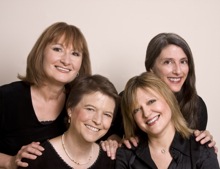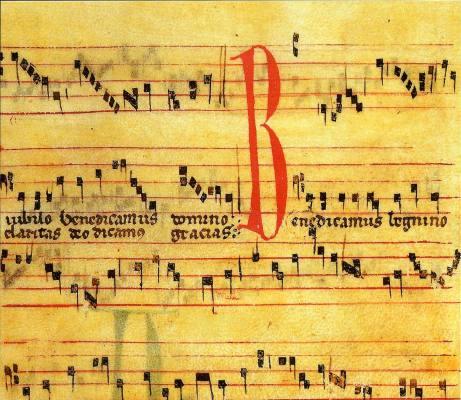
T he performance by Anonymous 4 last Saturday evening in the Friends of Chamber Music’s Early Music series was beautiful, without doubt.
- Marsha Genensky
- Susan Hellauer
- Jacqueline Horner-Kwiatek
- Ruth Cunningham
A s I listened, entranced by the singing, I began to imagine medieval religious thought—the pious thought and feeling that motivated the creation and preservation of the Codex—as a kind of improvisation and ‘modal fictionalism’ that aimed to make the tenets of belief that the text expresses come true or be true. More than an expression of belief or mere devotional act, the words and music seem intent on establishing the possible world in which what the words say really happens. In other words, the impression that struck me was that the Las Huelgas nuns’ practice was far more radical than any ordinary kind of piety.
S ome links to recent books on modal fictionalism are at the bottom of this blog post, for your interest.
| Motet Claustrum pudicicie Virgo viget, Triplum | |
| Claustrum pudicicie, virginis triclinium, | Cloister of modesty, seat of virginity, |
| spes tocius leticie... | hope of all happiness... |
| virgo filium fac nobis propicium... | Virgin, make your Son merciful to us... |
| Discant | |
| Fa fa mi fa mi re mi, | Fa fa mi fa mi re mi, |
| Ut mi sol re mi ut fa fa, | Ut mi sol re mi ut fa fa, |
| Fa re fa fa re ut re mi ut re mi. | Fa re fa fa re ut re mi ut re mi. |
| Est fatuum spernere | It is foolish to despise these |
| quia musicalia... | because they are the elements of music... |
| Alleluya: Que est ista? | |
| Alleluya! | Alleluia! |
| Que est ista tam formosa, | Who is she, so lovely, |
| pulcra ut luna, | beautiful as the moon, |
| electa ut sol, | noble as the sun, |
| terribilis ut castrorum acies ordinata? | awesome as an army arrayed for battle? |
B oth the Codex las Huelgas and the Codex Calixtinus (the subject of previous Anonymous 4 recordings and concerts) are noted for their importance in understanding the development of 12th and 13th Century polyphony. They are important on account of their scope, fine condition, and readability. There are oddities of alignment between the voices (see the reproduction manuscripts, links below). In the note-against-note style, it was fairly clear which notes went together, since they pair off nicely with few exceptions. On the other hand, when the upper voice is allowed to have more than one note for every note in the lower voice, it’s hard to determine on which notes the two voices coincide. Karp’s book is a good place to begin understanding the intervalic alignments and dissonances, especially the note-against-note portions.
R hythmic and metrical ambiguities in the notation also reveal how much improvisational latitude there is (was). These ambiguities and the performance decisions and interactions between the ensemble members last Saturday night were the cause of my meditations on modal fictionalism. The ambiguities are obliterated in modern transcriptions (like these), so you really need to look at [facsimiles of] the original Codices. Is the meter duple or triple?

P ossible-worlds semantics for modality says that an expression is possibly true if it is true in some possible world. In classical propositional logic, one can show that every logically-consistent set of propositions can be embedded in a ‘maximal consistent set’. A ‘maximal consistent set’ is an abstraction of a ‘possible world’—for the nuns of the Codex, a possible world where Mary is really Queen and all members of the Order really are virtuous. But the abstraction depends on the fact that modal logics are ‘finitary’, and it seems false that an infinite collection of sets of sentences—each finite subset of which is intuitively ‘possible’ in natural language—has the property that the whole set is possible.
S o questions about necessity (or what ‘has to be’, or what ‘must be true’, or what cannot be otherwise) and possibility (or what can be, or what could be otherwise) are questions about modality—and such questions are what the works that comprised the Anonymous 4’s ‘Secrets of las Huelgas’ program so strongly evoked.
F ictionalism is a philosophical approach which treats the claims or assertions as analogous to fictional claims: claims that are not asserted literally, but which are put forward to serve a specific useful function of deliberation. There is even a modal fictionalism in theoretical mathematics (link below).
B ut, despite the name ‘modal fictionalism’, it’s not primarily fictionalism about claims of necessity and possibility, but rather a fictionalist approach to claims about possible worlds. (For instance, modal fictionalism is not normally fictionalist about the claim that “it is possible that there be a species of tail-less kangaroo”, but rather about the claim that “there is a possible world in which there is a species of tail-less kangaroo”.)
T heories employing possible-worlds constructs have been found to be very useful in philosophy—‘thought experiments’, basically, to discover the implications and meanings of constellations of propositions. The ‘modal fictionalism’ approach has been extensively applied over the past 30 years in ethics and in areas other than philosophy, like linguistics, logic, and probability theory.
I sn’t it extravagant to believe that just because a situation or constellation of facts is possible, it must in some sense exist? ‘Weak modal fictionalists’ say ‘yes’ to this; they take commitments to the existence of possible worlds that are constructed in the mind—merely hypothetical situations, non-actual but possible situations—to be strictly or possibly false, and so they avoid the problems of believing in possible worlds. Nevertheless, they claim, they derive the epistemological benefits of using these seemingly problematic theories.
I think that the the nuns of Las Huelgas ca. 1300 may have been what we would today call ‘strong’ modal fictionalists—who say it is not extravagant at all.
A wonderful performance, with much food for thought...
- Anonymous4 website
- Anonymous4. Four Centuries of Chant. (Harmonia Mundi, 2009.)
- Anonymous4. Miracles of Compostela. (Harmonia Mundi, 2008.)
- Codex las Huelgas, OMIfacsimiles edition
- Codex las Huelgas page at Wikipedia
- Codex las Huelgas page at Goldbergweb.com
- Begbie J. Theology, Music and Time. Cambridge Univ, 2000.
- Berman C. Medieval Religion: New Approaches. Routledge, 2005.
- Bratman M. Faces of Intention: Selected Essays on Intention and Agency. Cambridge Univ, 1999.
- Broad J, Green K, eds. Virtue, Liberty, and Toleration: Political Ideas of European Women, 1400-1800. Springer, 2007. [esp. Chapter 1, Earl Richards]
- Bueno O, Linnebo O, eds. New Waves in Philosophy of Mathematics. Palgrave Macmillan, 2009. [esp. Chapter 3 on mathematical fictionalism]
- Danielson P. Artificial Morality: Virtuous Robots for Virtual Games. Routledge, 1992.
- Fuller S. Perspectives on Musical Notation. In The Codex Calixtinus, in El Códice Calixtino y la Música de su Tiempo, J. López-Calo and C. Villanueva, eds. Fundación Pedro Barrié da la Maza, 2001, pp. 183-234.
- Fuller S. Early Polyphony to circa 1200. In The Cambridge Companion to Medieval Music, M. Everist, ed. Cambridge Univ, 2010.
- Fuller S. Modal Discourse and Fourteenth-Century French Song: A ‘Medieval’ Perspective Recovered? Early Music History 1998; 17: 61-108.
- Sarah Fuller page at SUNY Stony Brook
- Hare C. On Myself and Other, Less Important Subjects. Princeton Univ, 2009.
- Hathorne G. 'Secret Voices' was a bonfire for the soul. KCmetropolis.org, 28-OCT-2009.
- Henriques L. Miracles of Sant'iago. Atrium Musicologicum blog, 04-APR-2009.
- Irwin J, ed. Sacred Sound: Music in Religious Thought and Practice. AARB, 1984.
- Johnston M. Saving God: Religion after Idolatry. Princeton Univ, 2009.
- Karp T. The Polyphony of Saint Martial and Santiago de Compostela. 2 vol. Univ California, 1993.
- Ledbetter M. Virtuous Intentions: The Religious Dimension of Narrative. AARB, 1989.
- Liggins D. Modal fictionalism and possible-worlds discourse. Phil Stud 2007; 138:151-60.
- Meyers D. Women and Religion in Old and New Worlds. Routledge, 2001.
- Miller F, VAndome A, McBrewster J, eds. Philosophy of Mathematics: Introduction to Mathematical Philosophy, Valuation, Logicism, Formalism, Constructivism, Fictionalism. Alphascript, 2009.
- Nichols S, ed. The Architecture of the Imagination: New Essays on Pretence, Possibility, and Fiction. Oxford Univ, 2006.
- Nolan D. Modal Fictionalism. Stanford Univ, 2007.
- Parens J. An Islamic Philosophy of Virtuous Religions: Introducing Alfarabi. SUNY, 2006.
- Petrie L. Anonymous4 reveals sacred secrets. San Francisco Classical Voice. OCT-2009.
- Raleigh S. Codex Calixtinus and the development of polyphony in the twelfth century. Vanderbilt Univ, 1998.
- Rosen G. Modal fictionalism. Mind 1990; 99: 327-54.
- Papers citing Gideon Rosen on Possible-Worlds
- Sainsbury R. Fiction and Fictionalism. Routledge, 2009.
- Saliers D. Music and Theology. Abingdon, 2007.
- Shaw M. The Paradox of Intention: Reaching the Goal by Giving Up the Attempt to Reach It. AARB, 1988.
- Westermeyer P. Te Deum: The Church and Music. Augsburg, 1998.
- Williams J, Stones A, eds. The Codex Calixtinus and the Shrine of St. James. Narr, 1992.
- The Way of St. James, page at spain.info
- Codex Calixtinus, OMIfacsimiles edition
S ince the late 12th Century, the Cathedral of Santiago in Compostela has possessed a manuscript entitled ‘Jacobus’ (Codex Calixtinus). How it found its way to Compostela is unknown, but it is undoubtedly a French product, probably compiled or writtin in Cluny around 1150. Although they represent a mere 10% of the music in Jacobus, the polyphonic works have received attention from scholars because they are among the earliest such pieces to have been written down. But the notation in Jacobus is ambiguous as to rhythm and meter, as well as to alignment of the pitches between the voice parts in the polyphony...”
— Susan Hellauer, Anonymous4 CD liner notes.
No comments:
Post a Comment